Rainwater harvesting is the process of collecting and storing rainwater instead of allowing it to flow away as runoff. This collected water can then be used for various purposes, thereby reducing reliance on municipal water supplies or groundwater. It’s an age-old technique that is gaining renewed importance in modern times due to increasing water scarcity and environmental concerns. The process typically involves capturing rainwater from surfaces like rooftops and directing it into storage systems such as tanks, reservoirs, or even groundwater recharge pits.
- Growing Importance of Rainwater’s Collection
- Benefits of Collecting Rainwater
- Techniques for Collecting Rainwater
- Design Considerations
- Installation Methods
- Maintenance of Rainwater Harvesting Systems
- Drought Preparedness: Rainwater collecting
- Legal Considerations and Guidelines
- Challenges and Solutions in Rainwater Harvesting
- Common Challenges-(Rainwater collecting)
- Water Quality Issues-(Rainwater collecting)
- Innovative Solutions (Rainwater collecting)
- Community and Educational Initiatives
- Conclusion
- Summary of the Key Points
- Call to Action
- Vision for a Sustainable Future
Growing Importance of Rainwater’s Collection
The increasing relevance of sustainable water practices among homeowners is driven by several critical factors. Global populations are rising, placing immense pressure on finite freshwater resources. Climate change is altering precipitation patterns, leading to more frequent droughts and floods, making reliable water sources even more unpredictable. Furthermore, the rising cost of utilities and the environmental impact of conventional water treatment and distribution systems are prompting individuals to seek more self-sufficient and eco-friendly alternatives. Rainwater collection offers a tangible solution to these challenges, empowering homeowners. To manage their water supply responsibly and reduce their ecological footprint.
Aim of the Article
This article aims to provide a comprehensive overview of the key benefits and techniques involved in rainwater harvesting. We will explore the diverse advantages, encompassing cost efficiency, environmental sustainability, and enhanced water self-sufficiency. Furthermore, we will explore various practical techniques for collecting, storing, and utilizing rainwater, ranging from simple DIY setups to more advanced integrated systems. Our goal is to equip homeowners with the knowledge and understanding necessary to make informed decisions about implementing rainwater harvesting solutions on their properties.
Benefits of Collecting Rainwater
Environmental Benefits
Water Conservation: Rainwater harvesting significantly reduces the demand for precious groundwater reserves, which are often over-extracted and slow to replenish. It also lessens the strain on municipal water treatment plants and distribution systems. Leading to lower energy consumption associated with pumping and purifying water. By utilizing a free, natural resource, communities can achieve greater water independence and bolster their resilience against droughts and increasing population demands.

Erosion Control: The uncontrolled flow of rainwater across impervious surfaces like roofs, driveways, and compacted soil can lead to severe soil erosion, carrying away valuable topsoil and nutrients. Collecting rainwater in barrels, cisterns, or rain gardens effectively intercepts this runoff, slowing it. Its velocity and allowing it to be absorbed or diverted in a controlled manner. This mitigates the risk of localized flooding, prevents sediment from entering storm drains and waterways, and protects delicate ecosystems from siltation and pollution.
Economic Advantages
Lower Water Bills: Implementing a rainwater harvesting system can lead to substantial financial savings for homeowners and businesses. By supplementing or even replacing a significant portion of their traditional water consumption with collected rainwater. Individuals can dramatically reduce their reliance on municipal water supplies. This directly translates to lower monthly water bills, especially in areas with tiered pricing or high water rates. The initial investment in a system often pays for itself over time through these ongoing savings.

Increased Property Value: Eco-conscious buyers value properties with sustainable systems like rainwater harvesting, increasing their desirability and worth. These systems demonstrate a commitment to eco-friendly living and can appeal to a broader range of potential buyers. The long-term cost savings on water bills, coupled with the environmental benefits, make homes equipped with rainwater harvesting systems an attractive investment, potentially increasing their resale value and marketability.
Self-Sufficiency and Resilience

Emergency Water Supply: Rainwater harvesting provides a crucial layer of self-sufficiency, offering a reliable alternative water source during emergencies. Natural disasters that disrupt municipal water supplies, stored rainwater. It can be vital for non-potable uses such as flushing toilets, bathing, and even as a pre-filtered source for further purification for drinking. This independence reduces vulnerability and enhances a household’s or community’s ability to cope with unforeseen water shortages.

Versatile Uses: The uses for harvested rainwater are diverse and extensive, reaching well beyond emergencies. It is ideal for landscape watering, nourishing gardens, lawns, and potted plants without consuming potable water. Rainwater is effective for washing vehicles, outdoor surfaces, and replenishing swimming pools or ornamental ponds. For indoor non-potable uses, it can be plumbed to flush toilets. (or) supply washing machines, further reducing the reliance on treated tap water and extending the overall utility of this precious resource.
Techniques for Collecting Rainwater
Rainwater harvesting is a multifaceted approach that involves several key components, careful design considerations, and various installation methods. Understanding each of these elements is crucial for a successful and efficient system.
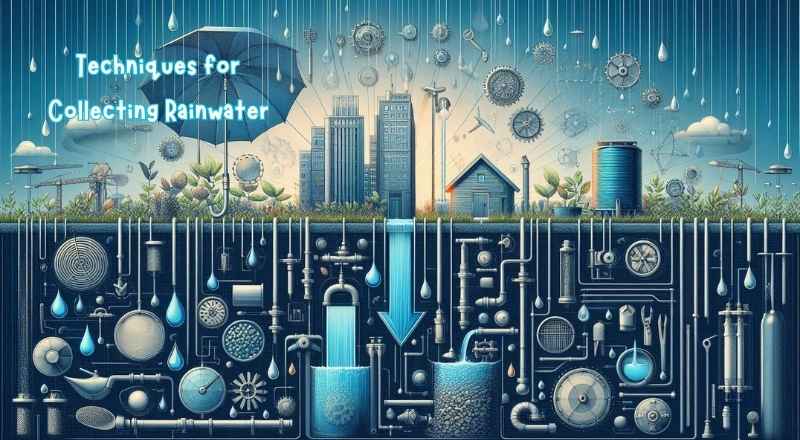
Basic Components of Rainwater Harvesting Systems
A well-functioning rainwater harvesting system relies on the harmonious interplay of several fundamental components, each playing a vital role in capturing, storing, and delivering clean water.
Gutters and Downspouts:
These form the initial collection network of any rooftop rainwater harvesting system.
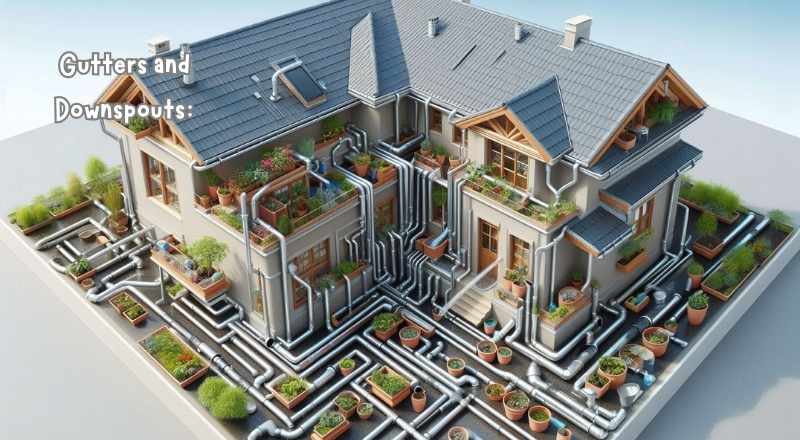
Importance of a well-designed collection system: Gutters, typically made from materials like PVC, aluminium, or galvanized steel, are installed along the edges of a roof to channel rainwater. Their sizing and slope are critical; they must be large enough to handle peak rainfall events without overflowing and should have a sufficient gradient to ensure efficient water flow towards the downspouts. The downspouts subsequently channel the water collected from the gutters into the storage tanks. Proper placement and a sufficient number of downspouts are essential to prevent water accumulation on the roof and ensure all runoff is captured. Regular cleaning of gutters to remove leaves, debris, and other obstructions is vital to maintain optimal water flow and prevent contamination of the collected water. First-flush diverters, which automatically divert the initial, most contaminated runoff away from the storage tank, are often integrated into this stage to improve water quality.
Storage Tanks:
Once collected, rainwater needs to be stored for later use. The choice of storage tank significantly impacts the system’s capacity, cost, and aesthetics.
Overview of options such as rain barrels and cisterns:

Rain Barrels: These are smaller, often cylindrical containers, typically ranging from 50 to 100 gallons in capacity. They are a popular choice for residential users due to their affordability, ease of installation, and suitability for small-scale applications like garden irrigation or car washing. Rain barrels are usually placed directly beneath a downspout and can be connected in series to increase storage capacity.
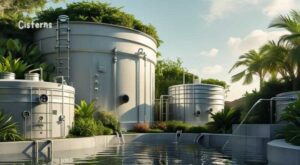
Cisterns: These are larger, more robust storage vessels, often designed for greater volumes of water, ranging from hundreds to thousands of gallons. Cisterns can be aboveground (visible and often aesthetically integrated into landscaping). Materials for cisterns vary widely and include concrete, fiberglass, polyethylene, and even modified metal tanks. The choice of material depends on factors such as water quality requirements, budget, and local regulations. Cisterns are ideal for applications requiring a significant water supply, such as whole-house non-potable use, emergency reserves, or agricultural irrigation. They often come equipped with features like filtration systems, overflow outlets, and spigots for easy access to the stored water.
Design Considerations
Beyond the basic components, the effective design of a rainwater harvesting system requires careful consideration of several factors to ensure its efficiency, sustainability, and the quality of the collected water.
Sizing:
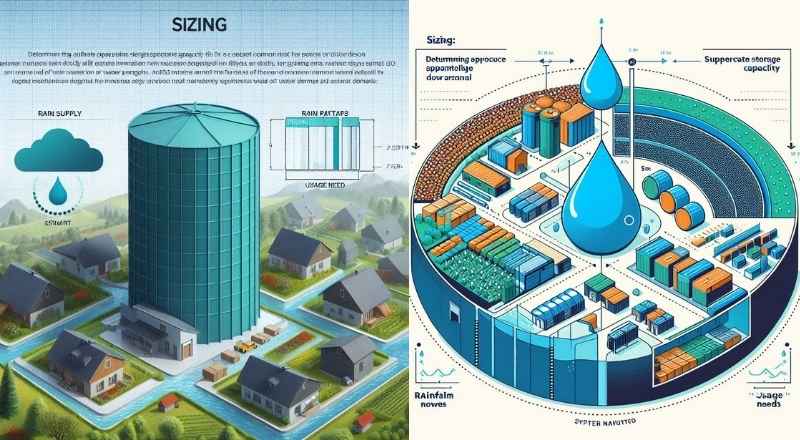
Determining the appropriate storage capacity is a critical design decision that directly impacts the system’s ability to meet water demands.
How to determine the appropriate size for storage based on rain patterns and usage needs: Sizing involves a comprehensive analysis of both water supply (rainfall patterns) and water demand (usage needs).

Rain Patterns: This requires historical rainfall data for the specific geographic location, including average annual rainfall, seasonal variations, and the frequency and intensity of significant rain events. The “catchment area” (typically the roof area) of the structure is also a key factor; a larger roof will collect more water. Formulas and online calculators often integrate these variables to estimate the potential volume of water that can be collected.
Usage Needs: This involves quantifying the intended use of the harvested water. Garden irrigation considers garden size and plant water needs. Non-potable household uses (toilet flushing, laundry) factor in occupants and their water habits. For potable water, daily per-person consumption is crucial.The goal is to balance the supply from rainfall with the water demand, ensuring there’s enough storage to bridge dry periods without excessive unused capacity.
Filtration Systems:

Maintaining the quality of harvested rainwater is paramount, especially if it’s intended for any use beyond basic irrigation.
Role of filtration in maintaining water quality: Rainwater, while generally clean from the sky, can pick up various contaminants from the roof surface and collection system, including leaves, dust, bird droppings, moss, and even airborne pollutants. Filtration systems are essential to remove these impurities and ensure the water is suitable for its intended purpose.
- Types of Filtration: Basic filtration often begins with a screen at the downspout to prevent larger debris from entering the tank. Further down the line, various types of filters can be incorporated:
- Sediment Filters: These devices eliminate smaller suspended particles and typically serve as the initial stage of fine filtration.
- Activated Carbon Filters: Used to remove odors, tastes, and certain organic chemicals.
- UV Sterilization: For potable water applications, UV lamps are employed to kill bacteria, viruses, and other microorganisms.
- Sand Filters: Larger-scale systems might use sand filters for more comprehensive physical filtration.
The complexity and type of filtration system will depend on the end-use of the water. Potable water systems require more rigorous multi-stage filtration and often disinfection. While water for irrigation might only need basic screening. Routine maintenance and cleaning of filtration components are essential to prevent blockages and maintain their efficiency.
Installation Methods
Once the components are chosen and the design is finalized, the actual installation of the rainwater harvesting system takes place. This can range from a straightforward do-it-yourself project to a complex undertaking requiring professional expertise.

DIY Installations:
For smaller, simpler systems, many homeowners opt for self-installation, which can be a cost-effective and rewarding endeavor.

Step-by-step guide for homeowners interested in self-installation:
- Site Assessment: Identify the best location for the storage tank (e.g., near a downspout, on stable, level ground).
- Gutter and Downspout Preparation: Ensure existing gutters are clean, clear of debris, and properly sloped. If necessary, install new downspouts or modify existing ones to direct water towards the tank.
- Tank Placement: Position the rain barrel or cistern on a sturdy, level base to prevent tipping and ensure proper drainage.
- Connecting the Downspout: Use a downspout diverter kit or a simple elbow attachment to channel water from the downspout directly into the tank’s inlet.
- Overflow Management: Install an overflow pipe from the tank that directs excess water away from the foundation of the building, ideally to a garden or storm drain.
- Spigot Installation: Attach a spigot or hose connection to the lower part of the tank for easy water access.
- First-Flush Diverter (Optional but Recommended): Install a first-flush diverter in the downspout to automatically discard the initial, dirty rainwater.
- Maintenance Access: Ensure easy access to the tank for cleaning and to the filters (if installed) for maintenance.
DIY installations are generally suitable for single rain barrels or small interconnected systems for garden use. Comprehensive research and strict compliance with local building regulations are crucial.
Professional Installation:
For larger, more complex, or integrated rainwater harvesting systems, hiring experts is often the most sensible and sometimes necessary choice.
When and why to consider hiring experts for more complex systems:
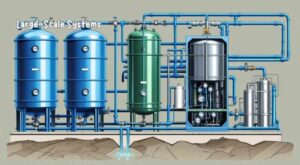
Large-Scale Systems: If the goal is to supply a significant portion of household water (e.g., for toilets, laundry, or even potable use). The system will likely involve larger cisterns, more advanced filtration and pumping systems. With the possibility of integration into existing plumbing infrastructure.
Underground Cisterns: Installing underground tanks requires excavation, proper structural support, and careful consideration of drainage and connections. To plumbing, all of which are best handled by experienced professionals.
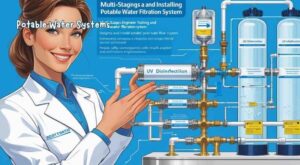
Potable Water Systems: If the harvested water is intended for drinking or cooking. It must meet stringent health and safety standards. Professionals can design and install multi-stage filtration, disinfection (e.g., UV treatment), and pressure systems to ensure water safety and compliance with regulations. They also possess expertise in conducting water quality assessments.
Complex Roof Structures: Irregular or multi-level rooflines may require custom guttering and downspout configurations that benefit from professional design and installation.
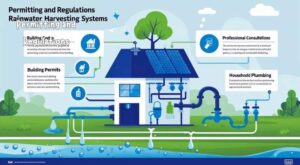
Permitting and Regulations: Many areas have specific building codes and permits required for rainwater harvesting systems, especially for larger installations or those connected to household plumbing. Professionals are knowledgeable about these regulations and can ensure the system is compliant.
Longevity and Warranty: Professional installers often provide warranties on their work and components, offering peace of mind and ensuring the system’s long-term performance. They have the expertise to optimize system performance, troubleshoot issues, and ensure proper integration with existing infrastructure.
Maintenance of Rainwater Harvesting Systems
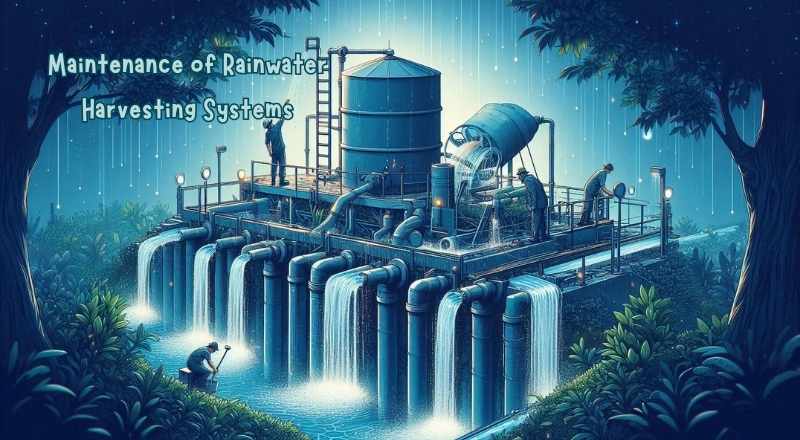
Dail maintenance of a rainwater harvesting system is crucial to guarantee its longevity, efficient operation, and the quality of the harvested water. Regular care ensures that the system operates optimally, providing a sustainable water source for various uses.
Regular Inspections: Rainwater collecting

Thorough and consistent inspections are the cornerstone of effective maintenance of rainwater harvesting systems. It’s imperative to routinely check all components for proper functionality and cleanliness. This encompasses, but is not:
Catchment Surfaces: Inspect roofs or other collection areas for debris (leaves, twigs, dirt), signs of wear, cracks, or loose materials that could contaminate the water or impede flow.
Gutters and Downspouts: Ensure they are securely attached, free from blockages, and properly sloped to direct water efficiently to the filtration and storage components. Look for any leaks or damage.
First Flush Diversion Systems: Verify that these systems are operating correctly, effectively diverting initial dirty runoff before it enters the main storage tank. Check for any clogs or malfunctions.
Filters and Screens: Regularly examine pre-filters, leaf screens, and other filtration mechanisms for accumulated debris or blockages. These are critical for preventing contaminants from entering the storage tank.
Pipes and Connections: Inspect all plumbing for leaks, cracks, or loose fittings. Verify that all connections are securely fastened and show no evidence of corrosion or deterioration.
Pumps (if applicable):
If your system has a pump, check its operation, listen for unusual noises, and ensure it’s primed and leak-free.
Storage Tanks: Conduct visual inspections of the exterior for any cracks, damage, or signs of algae growth. Check tank access points for secure sealing.
Outlets and Spigots: Ensure these are functioning correctly and free from blockages or leaks.
Regular inspections allow for early detection of potential issues, preventing minor problems from escalating into costly repairs or system failures.
Cleaning Procedures- Rainwater collecting
Beyond inspections, routine cleaning is essential to maintain water quality and system performance.
 Gutter Cleaning:
Gutter Cleaning:
Gutters and downspouts are the initial pathways for rainwater into your system, making their cleanliness paramount.
Frequency: Clean gutters at least twice a year, ideally in late spring after pollen season and late fall after leaf drop. More frequent cleaning might be required in areas with dense foliage.
Debris Removal: Manually clear away leaves, twigs, dirt, and other accumulated debris. A gutter scoop or hand trowel can be useful.
Flushing: Once the waste has been removed, carefully rinse the drains and downspout using a clear away any residual deposit, and confirm unobstructed flow. Check that water flows freely through downspouts and into the first flush diverter or directly into the filtration system.
Addressing Blockages: If a blockage is suspected in a downspout, use a plumber’s snake or a strong jet of water to dislodge it.
Gutter Guards: Consider installing gutter guards or screens to minimize the amount of debris entering the system, reducing the frequency of manual cleaning. However, these also require occasional cleaning to prevent buildup on their surface.
Tank Maintenance (Rainwater colleting)
The storage tank is the core of a rainwater harvesting system, and its proper maintenance is crucial for preserving water quality.
 Sediment Removal: Over time, fine sediment tends to accumulate at the bottom of the tank. The frequency of tank cleaning depends on the amount of incoming sediment. Which is influenced by the effectiveness of pre-filtration.
Sediment Removal: Over time, fine sediment tends to accumulate at the bottom of the tank. The frequency of tank cleaning depends on the amount of incoming sediment. Which is influenced by the effectiveness of pre-filtration.
For potable use, professional tank cleaning might be recommended every few years.
For non-potable uses, less frequent cleaning (e.g., every 3-5 years) may suffice, depending on water quality and visual inspection.
Drain tank, remove sludge carefully to prevent damage.
Algae Control: Prevent direct sunlight from reaching the water inside the tank, as this promotes algae growth. The majority of rain tanks are opaque for this specific reason. If algae are present, the tank needs to be cleaned thoroughly.

Filter Maintenance: Regularly clean or replace filters (e.g., mesh filters, sediment filters, activated carbon filters) according to the manufacturer’s recommendations. Blocked filters decrease flow rates and adversely affect water quality.
Pre-filters/Leaf Screens: Clean these frequently, especially after heavy rainfall or periods of high debris.
In-line Filters: Check and replace cartridges as recommended.
Seasonal Preparedness: Rainwater collecting
Preparing your rainwater harvesting system for seasonal changes, especially extreme weather, is vital for its protection and continued operation.
Winterization (for freezing climates):
Drainage: In regions experiencing freezing temperatures, drain all exposed pipes, pumps, and components that could be damaged by freezing water. This prevents pipes from bursting.
 Disconnecting Components: Disconnect and store pumps indoors if they are not specifically designed for outdoor winter use.
Disconnecting Components: Disconnect and store pumps indoors if they are not specifically designed for outdoor winter use.
Tank Level: Consider maintaining the tank at a lower level if there’s a risk of the water freezing solid and expanding, which could damage the tank structure. Some systems are designed to handle freezing; consult your system’s manual.
Insulation: Insulate exposed pipes and components to provide an extra layer of protection against freezing.
Pre-Monsoon/Heavy Rainfall Preparation:
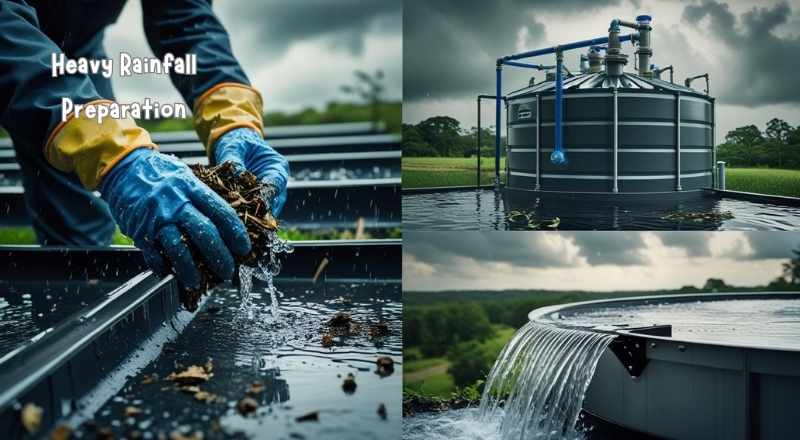
Thorough Cleaning: Before heavy rains, clean gutters, downspouts, and pre-filters for maximum collection.
System Check: Verify that all components are in good working order and securely fastened to withstand strong winds or heavy rain.
Overflow Management: Ensure the overflow mechanism is clear and functional to prevent flooding around the tank.
Drought Preparedness: Rainwater collecting
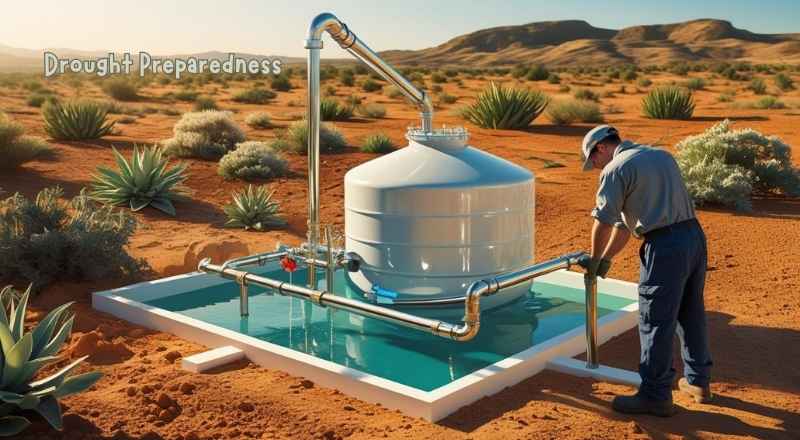
Conservation: During dry spells, be mindful of water usage to conserve your stored rainwater.
System Check: Even during droughts, periodically check the system for any issues that might arise from prolonged disuse, such as seized valves or pump issues.
By adhering to these maintenance practices, you can ensure your rainwater harvesting system remains a reliable and efficient source of water for years to come, contributing to water conservation and sustainability.
Legal Considerations and Guidelines
Understanding Local Regulations
Navigating the legal landscape of rainwater harvesting is crucial, as regulations can vary significantly from one region to another, and even within different municipalities of the same state or country. These variations often stem from differences in water rights, environmental protection laws, and public health concerns. Some areas may have specific zoning ordinances that dictate where and how rainwater harvesting systems can be installed, while others might offer incentives like tax credits or rebates for adopting such systems. It’s essential to research and understand these local nuances to ensure compliance and avoid potential legal issues. This includes examining building codes, plumbing codes, and any specific environmental regulations related to water collection and discharge.
Permitting Processes
The requirement for permits to install a rainwater harvesting system is not universal and largely depends on the scale and intended use of the system, as well as local regulations. For smaller, non-potable systems used for irrigation or toilet flushing, permits may not be necessary in some jurisdictions.
Larger systems, particularly those connected to a building’s plumbing for potable uses or involving significant structural modifications, almost always require permits.
The permitting process typically involves submitting detailed plans of the proposed system to the local building. Understanding when permits are required and how to obtain them is a critical step in the planning phase to ensure a smooth and legal installation. This often involves contacting the relevant municipal or county offices and familiarizing oneself with their specific application procedures and requirements.
Safety and Compliance (Rainwater collecting)

Safety and compliance are paramount when implementing rainwater harvesting systems, particularly concerning water quality. The primary health consideration revolves around whether the collected water is intended for potable (drinking, cooking) or non-potable (irrigation, toilet flushing, laundry) uses. Potable rainwater requires stringent filtration, purification, and disinfection to remove contaminants like bacteria, viruses, chemicals, and debris from runoff.
This often involves multi-stage filtration, UV sterilization, or chlorination. Regular testing of the water quality is also crucial to ensure it meets public health standards. For non-potable uses, while the purification requirements are less strict, it is still important to prevent the growth of harmful bacteria and algae, and to clearly label non-potable water lines to prevent accidental consumption. Furthermore, systems must be designed to prevent cross-contamination with the public water supply, often requiring backflow prevention devices. Compliance also extends to proper system maintenance, including regular cleaning of gutters, downspouts, and storage tanks to prevent sediment buildup and microbial growth. Adhering to these safety and compliance guidelines protects both the users of the harvested water and the broader public health.
Challenges and Solutions in Rainwater Harvesting
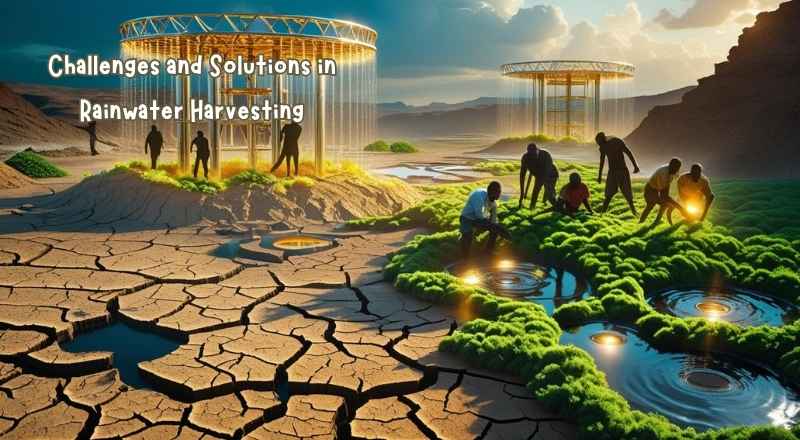
Rainwater harvesting, while a promising solution for water scarcity, presents a unique set of challenges that need to be addressed for its widespread and effective implementation. However, alongside these hurdles, innovative solutions and community-driven initiatives are paving the way for more efficient and sustainable rainwater utilization.
Common Challenges-(Rainwater collecting)
Implementing rainwater harvesting systems often encounters practical difficulties that can impact their feasibility and effectiveness. Understanding these challenges is crucial for developing robust and adaptable solutions.
Space Limitations: Rainwater collecting
One of the primary concerns, particularly in urban and densely populated areas, is the availability of adequate space for collection and storage systems. This challenge manifests in several ways:
Rooftop Area: The size and configuration of a building’s roof directly influence. The potential volume of rainwater that can be collected. Small or irregular roof surfaces can significantly limit collection capacity.
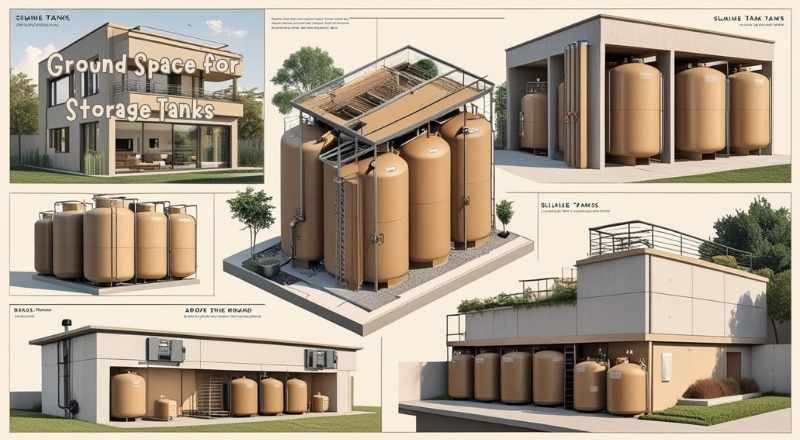
Ground Space for Storage Tanks: Storage tanks, whether underground or above-ground, require a substantial ground footprint. In compact residential plots or commercial properties, allocating sufficient space for large tanks can be difficult. This frequently requires innovative solutions such as slimline tanks and integrated architectural designs.
Infrastructure Constraints: Existing underground utilities, building foundations, and landscaping can further complicate the placement and installation of collection pipes and storage units.
Aesthetics: Large, visible storage tanks might be considered aesthetically unpleasing in certain architectural contexts. Leading to a preference for less conspicuous or subterranean options. Which can be more complex to install.
Water Quality Issues-(Rainwater collecting)

Ensuring the quality of collected rainwater is crucial for its intended applications, particularly when it is designated for drinking purposes. Several factors can lead to contamination:
First Flush Contaminants: The initial rainfall after a dry period can carry a significant amount of accumulated debris, dust, leaves, bird droppings, and other pollutants from rooftops and collection surfaces. This “first flush” is often highly contaminated and needs to be diverted or filtered out.
Atmospheric Pollution: In industrial or highly polluted areas, rainwater can absorb airborne pollutants, including chemicals and particulate matter, during its descent.
Roof Material Leaching: Certain roofing materials, such as older asphalt shingles or those containing lead, can leach harmful substances into the collected water, making it unsuitable for some applications.
Storage Tank Contamination: Stagnant water in tanks can become a breeding ground for bacteria, algae, and mosquito larvae if not properly maintained. Insufficiently sealed tanks can also allow ingress of pests and airborne contaminants.
Pipe and Gutter Debris: Clogged gutters and downspouts can accumulate organic matter, leading to decomposition and potential bacterial growth that can affect water quality. Regular cleaning and maintenance are essential.
Innovative Solutions (Rainwater collecting)
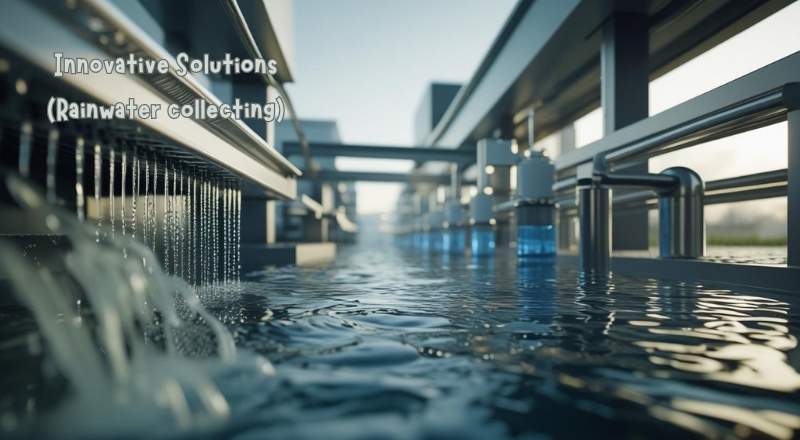
Addressing the challenges in rainwater harvesting requires a multi-faceted approach, leveraging technological advancements and creative design.
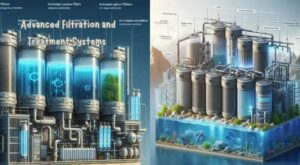
Advanced Filtration and Treatment Systems: Modern rainwater harvesting systems often incorporate multi-stage filtration units, including mesh filters, sediment filters, activated carbon filters, and UV sterilization. These technologies effectively remove physical particles, odors, chemicals, and microbial contaminants, making the water safe for various uses.
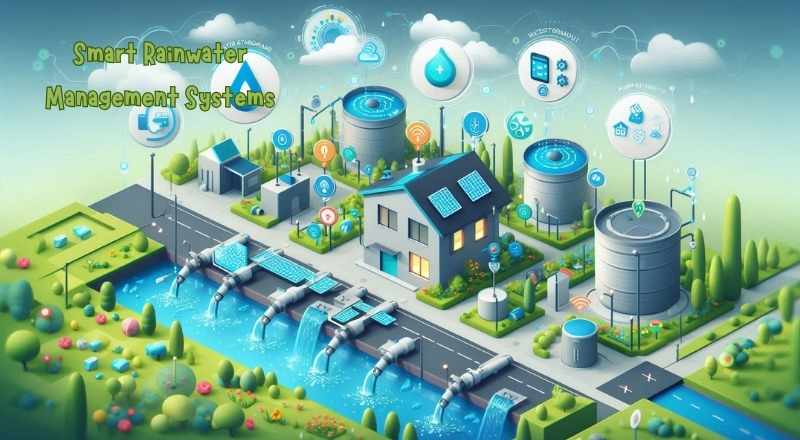 Smart Rainwater Management Systems: These systems utilize sensors and automation to optimize water collection, storage, and distribution. They can monitor rainfall patterns, tank levels, and even water quality, automatically diverting the first flush, controlling pump operations, and alerting users to maintenance needs.
Smart Rainwater Management Systems: These systems utilize sensors and automation to optimize water collection, storage, and distribution. They can monitor rainfall patterns, tank levels, and even water quality, automatically diverting the first flush, controlling pump operations, and alerting users to maintenance needs.
Integrated Architectural Designs: Architects and urban planners are increasingly integrating rainwater harvesting into building designs from the outset. This includes designing roofs for maximum collection efficiency, incorporating aesthetically pleasing and space-saving underground or slimline storage tanks, and utilizing green roofs that filter and store rainwater.
Modular and Scalable Systems: Modular components enable customizable and expandable rainwater harvesting systems to fit space and water needs. Such systems are often simpler to install and maintain.
Permeable Pavements and Rain Gardens: While not traditional “harvesting” in the sense of tank storage, these innovative urban landscaping solutions promote groundwater recharge and reduce stormwater runoff. Permeable pavements infiltrate rainwater; rain gardens capture, filter, and slowly release stormwater into the soil.

Internet of Things (IoT) Integration: IoT sensors can provide real-time data on rainfall, tank levels, and water usage, allowing for more efficient management and proactive maintenance of rainwater harvesting systems. This data can also inform water conservation strategies.
Community and Educational Initiatives
Beyond technological solutions, fostering awareness and promoting collective action are vital for the widespread adoption and success of rainwater harvesting.
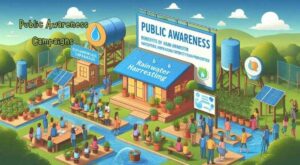
Public Awareness Campaigns: These initiatives aim to educate the public about the benefits of rainwater harvesting, including water conservation, reduced utility bills, and environmental protection. Campaigns often use workshops, demonstrations, and informative materials.
Government Incentives and Subsidies: Many governments offer financial incentives, tax breaks, or subsidies for installing rainwater harvesting systems, making them more affordable and accessible to households and businesses.
School and University Programs: Integrating rainwater harvesting into educational curricula at various levels helps. To instill environmental consciousness and practical skills from a young age, fostering a future generation that values water conservation.
Community-Led Projects: Local communities can play a crucial role in implementing large-scale rainwater harvesting projects. Such as building community-level storage tanks or revitalizing traditional water bodies. These initiatives frequently cultivate a sense of ownership and shared responsibility.
Training and Skill Development: Offering training to plumbers and individuals on the correct installation, maintenance, and operation of water harvesting systems guarantees their long-term efficiency and sustainability
Demonstration Projects: Highlighting rainwater harvesting systems in public spaces, parks, or communities can serve as compelling examples, motivating others to implement initiatives.
Conclusion
Summary of the Key Points
This exploration into rainwater harvesting has illuminated its multifaceted benefits, practical techniques, and crucial considerations. We’ve seen how this age-old practice offers a sustainable solution to water scarcity, reducing reliance on municipal supplies and lowering water bills. Environmentally, it lessens the strain on local ecosystems, recharges groundwater, and mitigates stormwater runoff, preventing erosion and flooding. Economically, beyond the initial setup, it provides a free and readily available water source.
We delved into various harvesting techniques, from simple rain barrels ideal for garden use. To more complex systems involving rooftop collection, sophisticated filtration. And large storage tanks for household consumption. Emphasis was placed on proper design, installation, and maintenance, including water quality, contaminants, and regulatory compliance.
We also touched upon the versatility of harvested rainwater for diverse applications, from irrigation and landscape watering to flushing toilets and even potable uses after appropriate treatment.
Call to Action
The evidence overwhelmingly points to rainwater harvesting as a powerful and accessible tool for personal and communal water management. It is more than just a niche interest; it is a viable and increasingly necessary option for individuals, communities, and businesses seeking greater water independence and environmental responsibility. We strongly encourage you to explore the feasibility of implementing rainwater harvesting solutions at your home or property. Start small with a rain barrel, investigate local incentives, or consult with experts to design a more comprehensive system. Every drop saved contributes to a larger positive impact.
Vision for a Sustainable Future
Looking beyond the immediate benefits, rainwater harvesting stands as a cornerstone of broader environmental stewardship practices. It embodies a philosophy of resourcefulness, conservation, and living in harmony with our natural environment. As climate patterns shift and water resources become more strained, embracing such sustainable practices is not merely an option but a critical imperative. Imagine communities where every building contributes to a decentralized water supply. Where green spaces flourish with harvested rainwater, and where our ecological footprint is significantly reduced. Rainwater harvesting is a tangible step towards this vision, fostering resilience, promoting ecological balance, and paving the way for a truly sustainable future for generations to come.

